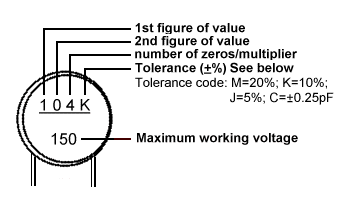Component Marking Codes
Resistors:
Resistors are often so small it is impractical to try to print each one with its value. So they are marked with a code printed on them in bands of colored paint. These bands give us the resistor's value.
|
 |
How to read them:
Start with the band closest to one end or, if it is difficult to tell, the band furthest away from the gold or silver band. Take the resistor above: the first band is orange - from the table this means three. The second band is white - 9. The third band is brown or 1 and is interpreted as the number of zeros to use, we get 0. 3, 9 and 0 - or 390 ohms.
The forth, or tolerance band, is silver, 10%. Therefore, the resistor is 390 ohms, 10% tolerance (or somewhere between 390 - 10% and 390 + 10%, or 351 and 429 ohms). This is more than adequate for most circuit requirements. Resistors are available which are 'exact' in value - however, these are not required in most circuits, and are often very, very expensive.
Capacitors:
| Most capacitors
will have their value printed on them. However, there are manufacturers
who use the "IEC" code. This code is a numerical code, but
works in a similar way to the resistor color code: two figures followed
by a multiplier. There is often a single letter code showing tolerance.
The code is worked out in pico farads, so you may have to use the appropriate metric multiplier. A capacitor may have a code '104K'. This decodes as follows - 0.1µF, 10%. The first two figures give us 10, the third figure gives us 0000, and the letter 10%. We normally express this as 0.1µF - only capacitors with a value below .001µF are expressed in picofarads. There may be a further figure marked - this would be the voltage rating of the capacitor (the maximum voltage at which you can use the capacitor.) |

Some circuits show capacitor and resistor
values as straight figures - e.g. 4.7pF. Other replace the decimal
point with the first letter of the sub-multiple (e.g. 4p7 is the
same as 4.7pF). Similarly with resistors: 6K8 means the same as
6.8K.
Examples: 103K = 0.01uF i.e 10nF with 10% Tolorance 104K = 0.1uF i.e. 100nF with 10% Tolorance |
|||||||||||||||||||||||||||||||||||||||||||||||||||||||||||
Metric Units and conversions:
| Most electronics publications, metric multipliers are used to simplify and shorten component values, etc. For example, capacitance is measured in Farads - but the Farad is a huge unit of measurement, much too large to be of any use as expressing capacitor values. So we use a suitable metric sub-multiple to save a lot of figures. Instead of saying for example, .000000000001 Farads we say 1 pico Farad (1pF). We have used only micro Farads (µF) and pico Farads (pF) here, but some publications use the abbreviation nano Farad (nF) so you should get to know these eventually, too. |
|
Unit Conversions
| 1000 pico units | = 1 nano unit, | 1000 nano units | = 1 micro unit |
| 1000 micro units | = 1 milli unit, | 1000 milli units | = 1 unit |
| 1000 units | = 1 kilo unit, | 1000 kilo units | = 1 mega unit |